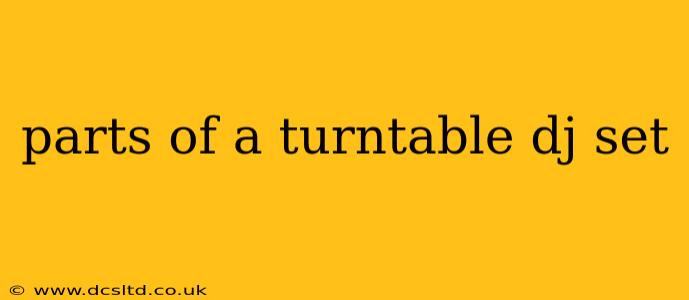For aspiring and seasoned DJs alike, understanding the intricacies of a turntable DJ setup is crucial. This isn't just about spinning vinyl; it's about mastering a complex interplay of technology and artistry. This guide breaks down the essential parts of a turntable DJ setup, going beyond the basics to provide a comprehensive understanding.
The Core Components: Turntables, Mixer, and Headphones
The heart of any turntable DJ setup lies in three fundamental components:
-
Turntables: These are the foundational instruments, allowing DJs to manipulate vinyl records. Key features to consider include direct-drive or belt-drive motors (direct-drive generally offering superior torque and stability), adjustable pitch control (crucial for beatmatching), and a sturdy build capable of withstanding the rigors of performance.
-
DJ Mixer: This is the central hub, connecting the turntables, allowing DJs to blend tracks seamlessly. Essential features include crossfaders (for transitioning between tracks), EQ controls (high, mid, and low frequencies) for shaping the sound, and multiple channels for connecting additional audio sources. Digital mixers often offer additional features like effects processors and sampler integration.
-
Headphones: DJs use headphones to cue up their next track, ensuring a smooth transition. Closed-back headphones are typically preferred to isolate the DJ's listening experience from the main speakers. High-fidelity sound reproduction is crucial for accurate beatmatching.
Beyond the Basics: Amplification and Speakers
While not strictly part of the turntable setup itself, these components are crucial for projecting the sound:
-
Amplifier: This device boosts the audio signal from the mixer to the speakers, ensuring sufficient volume and power. Choosing the right amplifier depends on the power requirements of your speakers and the size of your intended venue.
-
Speakers: These are the devices that project the DJ's mixed audio to the audience. Active speakers (with built-in amplifiers) are often preferred for ease of use, while passive speakers (requiring a separate amplifier) can offer superior sound quality with the right setup. The speaker selection depends largely on the venue size and desired sound characteristics.
Essential Accessories: The Unsung Heroes
Several accessories significantly enhance the DJ experience:
-
Slipmats: These are placed on the turntable platter, providing a smoother surface for the vinyl and preventing scratches. They also aid in techniques like scratching and beat juggling.
-
Needle/Cartridge: This is the crucial component responsible for converting the grooves in the vinyl record into an electrical signal. High-quality cartridges are essential for optimal sound reproduction. Regular needle replacements are important to prevent damage to your records.
Software and Controllers: Expanding Possibilities
While traditional turntable setups rely solely on hardware, many DJs integrate software and controllers:
-
DJ Software (e.g., Traktor, Serato, Rekordbox): Software provides advanced features such as looping, sampling, and effects processing, complementing the capabilities of the hardware setup.
-
MIDI Controllers: These devices often connect to DJ software and provide additional control options beyond what's available on a mixer, enabling creative experimentation.
What is the most important part of a DJ turntable setup?
This is subjective and depends on individual preferences and priorities. However, for most, the turntables themselves are the most crucial piece, followed closely by the mixer, as they are the foundation for mixing and manipulating music. Without functional and quality turntables and a mixer, the rest of the components are irrelevant.
What are the different types of turntables used in DJing?
Direct-drive and belt-drive turntables are the two primary types. Direct-drive offers immediate response and higher torque, ideal for scratching, while belt-drive offers smoother, less noisy operation, although often with less torque.
How do I choose the right turntable for my DJ setup?
Consider your budget, desired features (pitch control range, motor type), and personal DJ style (scratching, beatmatching, etc.). Research reviews and compare specifications before making a decision.
How do I connect my turntables and mixer?
Use RCA cables to connect the outputs of your turntables to the inputs of your mixer. Consult your equipment manuals for specific connection instructions.
This comprehensive overview aims to provide a clear understanding of the various components within a turntable DJ setup, highlighting both the essential elements and the optional additions that enhance the creative potential. Remember, the best setup is the one that suits your individual needs and artistic expression.
